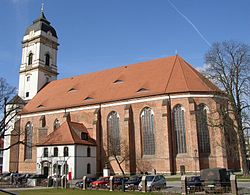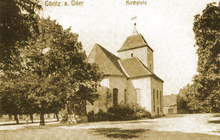- Bishopric of Lebus
-
Prince-Bishopric of Lebus
Fürstbistum Lebus (de)
Diecezja lubuska (pl)State of the Holy Roman Empire[1] ← 
1248–1555  →
→Coat of arms
St. Mary's Cathedral, Fürstenwalde Capital Lebus
Göritz (Górzyca) from 1276
Fürstenwalde from 1373Government Prince-Bishopric Historical era Middle Ages - Diocese established 1125 - Purchased from
Poland1248 - Secularized 1555 - Incorporated into
Brandenburg1598 Today part of  Germany
Germany
 Poland
PolandThe Bishopric of Lebus (German: Bistum Lebus; Polish: Diecezja lubuska) was a Roman Catholic diocese and later an ecclesiastical territory of the Holy Roman Empire. It existed from 1125 until 1598. The diocese encompassed areas on both sides of the Oder River around the town of Lebus later called Lubusz Land.
Contents
History
The diocese was established about 1125 by the Piast Duke Bolesław III Wrymouth of Poland in the lands west of Greater Poland settled by pagan Polabian Slavs, in order to counter the eastward expansion of the Holy Roman Empire expedited by Emperor Henry V and the Archbishopric of Magdeburg. Duke Bolesław prompted the construction of St. Adalbert Cathedral in Lebus, consecrated to the diocesan patron saint Adalbert of Prague, which was later destroyed.[2] Lebus was a suffragan diocese of the Archbishopric of Gniezno, a first bishop Bernard is documented in 1133, who is identical with Bernard of Spain, a missionary among the Pomeranians.
With the fragmentation of Poland among Bolesław's sons the influence of the Empire increased. Lebus fell to the Duchy of Silesia held by the heirs of Bolesław's first-born son Władysław II the Exile, and the area became a destination of the German Ostsiedlung. After the Silesian Duke Henry II the Pious had died at the 1241 Battle of Legnica, his son Bolesław II the Bald in 1248 finally lost the Lubusz Land to the Magdeburg archbishopric and the Ascanian margraves of Brandenburg, who began to attach the territories east of the Oder to their possessions as the Neumark ("New March") region. While the Ascanians and the Wettin archbishops competed to win influence, the diocese itself remained subordinate to Gniezno and the Lebus bishops maintained the interests of the Polish Piast rulers. In view of the pressure exerted by Brandenburg, the bishops in 1276 moved the episcopal seat to Göritz (Górzyca) east of the Oder.
When in 1320 the last Ascanian margrave Henry II died with no heirs the dispute rekindled. Bishop Stefan II supported King Władysław I the Elbow-high of Poland, when he campaigned the Brandenburgian Neumark. In revenge the new Wittelsbach margrave Louis I of Brandenburg in 1325 raided Górzyca and demolished the cathedral. Bishop Stephan II fled to Poland and not until 1354 an agreement was settled between Bishop Henry II Bencz and Margrave Louis II the Roman upon the reinstallation of the bishopric at Lebus.
Nevertheless in 1373 the newly erected cathedral was devastated again by the troops of Emperor Charles IV in the conflict between the Imperial Houses of Wittelsbach and Luxemburg over the Brandenburgian heritage. The bishop took residency in Fürstenwalde and in 1385 the cathedral chapter was moved there too. Not before 1424 the Brandenburg Elector Frederick I of Hohenzollern managed to separate the bishopric from Gniezno and to assign it as a suffragan to the Magdeburg archdiocese. In 1518 the bishops of Lebus acquired the Lower Lusatian lordships of Beeskow and Storkow.
As since 1513 the House of Hohenzollern also had held the office of the Magdeburg archbishops, Lebus finally turned Protestant and was secularized in 1555. The former bishopric was finally incorporated into Brandenburg, when in 1598 the last Lutheran administrator Joachim Frederick of Hohenzollern became elector.
Legacy
When in 1930 the former Lebus diocesan area became part of the new Diocese of Berlin the latter considered itself in the tradition of Lebus – and three more defunct dioceses – and adopted Lebus' diocesan crest as part of Berlin's diocesan coat of arms. Between 1951 and 1972 the Catholic jurisdiction in the Polish-annexed areas of former Lebus diocese, also comprising further areas, was officially titled the Apostolic Administration of Cammin, Lebus and Schneidemühl Prelature (Polish: Administracja Apostolska Kamieńska, Lubuska i Prałatury Pilskiej).
Composition
Though the considerably small though quite affluent diocese consisted only of one archdeaconry, its 172 parishes were divided into eight main rectories: Falkenhagen, Frankfurt (Oder), Kostrzyn (Küstrin), Müncheberg, Ośno (Drossen), Rzepin (Reppen), Seelow and Sulęcin (Zielenzig). The territory of the prince-bishopric was made up of the three Ämter Lebus, Fürstenwalde and Beeskow.
Bishops of Lebus
- 1133–1141 Bernard
- 1148–1158 Stefan I
- ?−1180 Gaudenty
- ?−1189 Przecław
- 1193 Arnold of Mogilno
- 1196–1201 Cyprian (Bishop of Wrocław 1201-1207)
- 1201–1233 Laurence
- 1233–1244 Henry I
- 1248–1250 Nanker
- 1252–1273 William I
- 1274–1284 William II, moved the episcopal see to Górzyca in 1276
- 1284–1299 Conrad
- 1300- ? John I
- 1311–1313 Frederick I
- 1326–1345 Stefan II (bishop-elect from 1317)
- 1345–1352 Apeczko of Ząbkowice
- 1353–1366 Henry II Bencz
- 1366–1375 Peter I of Opole
- 1375–1382 Wenceslaus of Liegnitz (also Bishop of Wrocław)
- 1382–1392 John II of Kittlitz (Bishop of Meissen 1393-1398, moved the episcopal see to Fürstenwalde in 1385)
- 1393–1397 John III Frost (Bishop of Olomouc 1397-1403)
- 1397–1418 John IV of Borsnitz (Archbishop of Esztergom from 1420)
- 1420–1423 John V of Waldow (Bishop of Brandenburg 1415-1420)
- 1423–1436 John VI of Waldow
- 1424–1436 Christoph von Rotenhan
- 1437–1439 Peter II von Burgsdorff
- 1440–1443 Conrad II Kron
- 1443–1455 John VII von Dreher
- 1455–1483 Frederick II Sesselmann
- 1484–1486 Liborius von Schlieben
- 1487–1490 Ludwig von Burgsdorff
- 1490–1523 Dietrich von Bülow
- 1524–1550 Georg von Blumenthal
- 1550–1555 John VIII Horneburg
- 1555–1598 Joachim Frederick of Hohenzollern
Notes
- ^ Imperial immediacy denied by Brandenburg.
- ^ Walter Stephan, "Das Madonnen-Siegel der VIADRINA und des Bischofs Dietrich von Lebus", in: Gabriel (April 2006), Sammlergilde St. Gabriel e. V. (ed.), cf. online extract, retrieved on 18 April 2011.
Categories:- Former countries in Europe
- States of the Holy Roman Empire
- States and territories established in 1248
- States and territories disestablished in 1555
- 1125 establishments
- 1598 disestablishments
- History of Brandenburg
- Roman Catholic dioceses in the Holy Roman Empire
- Former Roman Catholic dioceses in Germany
- Religious organizations established in the 1120s
- Roman Catholic dioceses established in the 12th century
Wikimedia Foundation. 2010.



